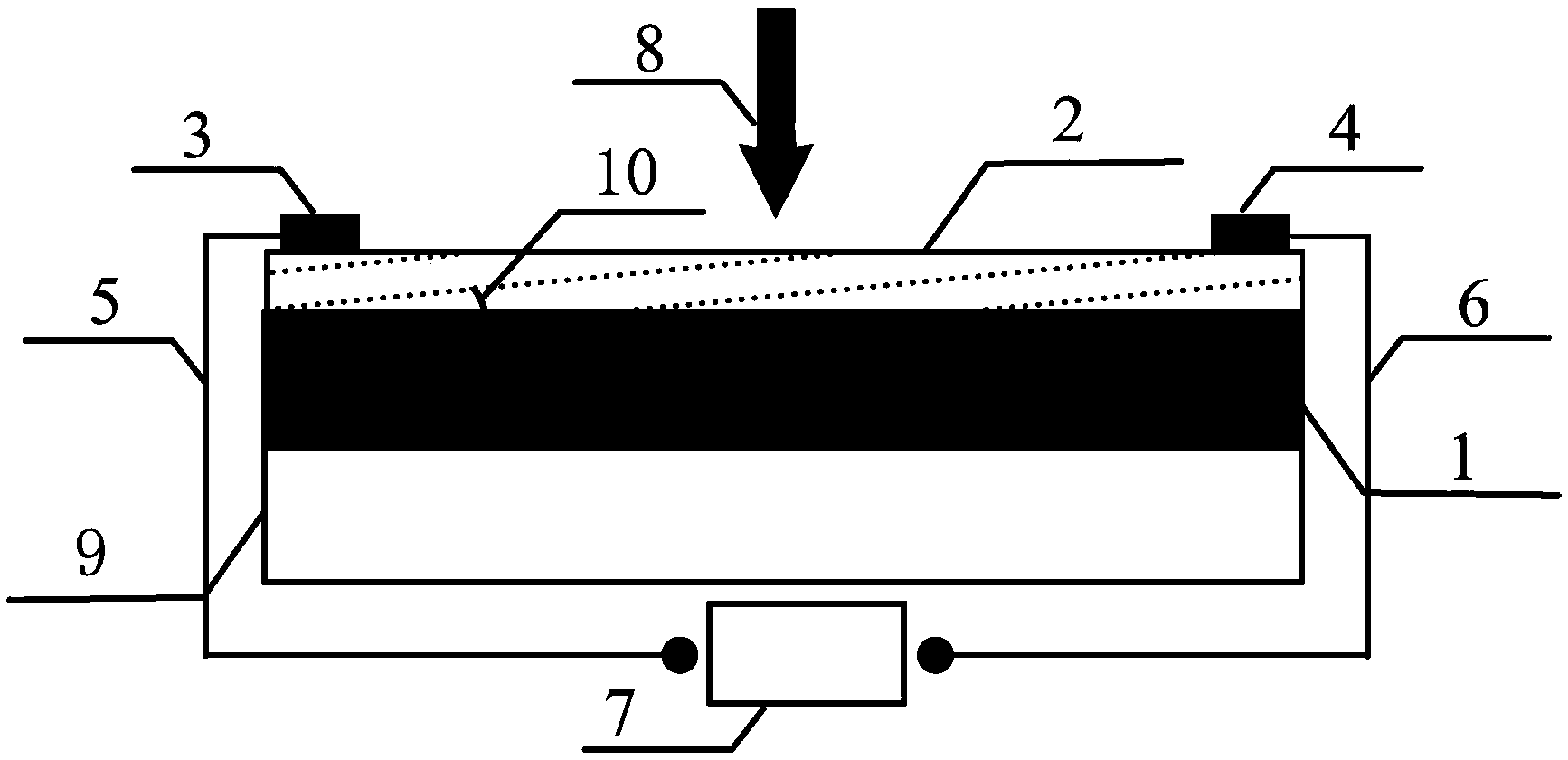Obliquely-tangential gallium arsenide single crystal photo-thermal detector
A thermal detector and gallium arsenide technology, which is applied in the field of optical and thermal detector preparation, can solve the problems of complex preparation process, low damage threshold, and high cost, and achieve high detection sensitivity, high damage threshold, and low cost.
- Summary
- Abstract
- Description
- Claims
- Application Information
AI Technical Summary
Problems solved by technology
Method used
Image
Examples
Embodiment 1
[0029] Embodiment 1: Oblique-cut gallium arsenide single crystal optical and thermal detector detects 405nm continuous light.
[0030] 1. N-type silicon-doped gallium arsenide single-crystal slices (size 10×5mm) obliquely cut at 10 degrees by known thermal evaporation methods 2 , with a thickness of 0.3 mm and a carrier concentration of 10 18 / cm 3 ) to prepare two silver electrodes on the surface, the electrodes are rectangular (1×5mm 2 ), the distance between electrodes is 8mm;
[0031] 2. Use conductive silver glue to stick two copper wires with a diameter of 0.1mm on the two silver electrodes respectively as the lead wires of the two electrodes;
[0032] 3. Connect the other end of the two electrode leads to the voltmeter as the output voltage signal test end;
[0033] 4. Select a voltmeter with an accuracy of 0.012%, and use the above-mentioned gallium arsenide single crystal photothermal detector to measure the voltage signal output of the continuous laser (output wa...
Embodiment 2
[0035] Embodiment 2: Oblique-cut gallium arsenide single crystal optical and thermal detector detects 532nm continuous light.
[0036] 1. With step 1-4 in embodiment 1;
[0037] Figure 5 It is the waveform diagram of the output voltage signal generated when the 532nm continuous laser is irradiated on the surface of the detector recorded by the voltmeter. It can be seen that when the laser energy irradiated on the sheet is 50mW, the amplitude of the output voltage signal is as high as 2.8mV, and the light and heat detector has high detection sensitivity to visible light.
Embodiment 3
[0038] Embodiment 3: Oblique-cut gallium arsenide single crystal optical and thermal detector detects 980nm infrared continuous light.
[0039] 1. Use the known thermal evaporation method to obliquely cut N-type silicon-doped gallium arsenide single crystal wafer (size 10×5mm) at 5 degrees 2 , with a thickness of 0.3 mm and a carrier concentration of 10 18 / cm 3 ) to prepare two In electrodes on the surface, the electrodes are rectangular (1×5mm 2 ), the distance between electrodes is 8mm;
[0040] 2. Use solder to weld two copper wires with a diameter of 0.1mm on the two In electrodes respectively as the leads of the two electrodes;
[0041] 3. Connect the other end of the two electrode leads to the voltmeter as the output voltage signal test end;
[0042] 4. Select a voltmeter with an accuracy of 0.012%, and use the above-mentioned obliquely cut gallium arsenide single crystal photothermal detector to measure the voltage signal output of the continuous laser (output wave...
PUM
| Property | Measurement | Unit |
|---|---|---|
| Bevel angle | aaaaa | aaaaa |
| Carrier concentration | aaaaa | aaaaa |
| Thermal conductivity | aaaaa | aaaaa |
Abstract
Description
Claims
Application Information
 Login to View More
Login to View More - R&D
- Intellectual Property
- Life Sciences
- Materials
- Tech Scout
- Unparalleled Data Quality
- Higher Quality Content
- 60% Fewer Hallucinations
Browse by: Latest US Patents, China's latest patents, Technical Efficacy Thesaurus, Application Domain, Technology Topic, Popular Technical Reports.
© 2025 PatSnap. All rights reserved.Legal|Privacy policy|Modern Slavery Act Transparency Statement|Sitemap|About US| Contact US: help@patsnap.com



